THE PAPERS OF JOSEPH HENRY"Interruptions and Embarrassments":
By Kathleen W. Dorman |
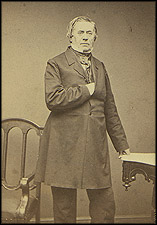 Joseph Henry, by Mathew Brady, ca. 1862, Brady Col- lection, National Archives. |
When the Civil War erupted in April 1861, the Smithsonian Institution suddenly found itself vulnerable. Located in the nation's capital between the Capitol Building and the White House, the institution was not immune from the forces threatening to turn the city of Washington, D.C., into an armed camp. In his first annual report to the governing board of the Smithsonian since the beginning of the national conflict, Joseph Henry suggested the war had not greatly affected the institution he managed. "The interruptions and embarrassments," he wrote, "although frequent, and in some cases perplexing, have not prevented the continuance of the general operations of the Institution." But Henry was evidently putting the best face on a bad situation, for the war's impact on the Smithsonian was considerable. Were it not for his steadfast leadership, the institution might have suffered permanent damage.1
In retrospect, this country had been heading toward civil war for many years. With the acquisition of vast territories in the West following the war with Mexico in the 1840s, tensions between the North and the slave-owning South increased. Shortly after the November 1860 election of Abraham Lincoln, who was firmly opposed to the further spread of slavery, South Carolina seceded, followed by Mississippi, Florida, Alabama, Georgia, Louisiana, and Texas. By the time Lincoln was inaugurated in Washington on March 4, 1861, Jefferson Davis was president of the Confederate States of America. Following the Confederate attack on Fort Sumter in Charleston Harbor, Lincoln called 75,000 militiamen into service on April 15, 1861.2
Despite this extended prelude, the city of Washington was only lightly defended when the war began. Although three million men eventually fought in the war, at its beginning the regular army numbered only between sixteen and seventeen thousand men, many of whom were stationed in the West. When Virginia voted to secede on April 17 and secessionists in Maryland cut telegraph and railroad lines between Baltimore and Washington, the nation's capital was virtually isolated from the rest of the country and swept with rumors of impending attack. Henry wrote his brother-in-law: "There is considerable probability that the Capital will be attacked if not by the Southern confederacy, by reckless filibusters, who, taking advantage of the state of war, will endeavor to surprise the city."3
 Balloon view of Washington by Wells, 1861 (click to see Smithsonian in back- ground). Harper's Weekly, July 27, 1861. |
The Smithsonian Building was in a vulnerable location,
cut off as it was from the rest of the city by the Washington Canal. It was also close to the Potomac River, which divided
the District of Columbia from Virginia, and particularly to one end of the Long Bridge, which linked the District and
Virginia. With public buildings barricaded and sandbagged and volunteer militia on guard duty, the secretary of war issued
the following order: "The Colonel of Ordnance will cause to be
issued to Professor J. Henry of the Smithsonian Institute twelve muskets and 240 rounds of ammunition, for the protection
of the Institute against lawless attacks."4
 Secretary of War Simon Cameron's order of April 20, 1861. Record Unit (RU) 7001: Henry Collection (b39, f31), Smithsonian Institution Archives (SIA). |
Housed in a castle-like structure that seemed to date from the middle ages, the Smithsonian had been in existence less than fifteen years when the war started. Congress established the institution in 1846 to fulfill the terms of the bequest of James Smithson, an Englishman who had left just over $500,000 to the United States to "found, at Washington, under the name of the Smithsonian Institution, an Establishment for the increase & diffusion of knowledge among men." Although established by Congress, the institution was not a government agency but a private organization with its own governing board. Under its first secretary, the physicist Joseph Henry, the fledgling institution supported scientific research by publishing a series of scholarly memoirs, making grants to and lending research materials to individual scholars, and by operating an international exchange of publications. The Smithsonian also coordinated a network of volunteer weather observers, who sent in their observations every month, and arranged for a number of telegraph operators to transmit daily weather readings to the Smithsonian. The building also housed a rapidly growing collection of specimens that were used both for research and for public exhibition.
In the first days of the war, volunteer troops trying to reach Washington from the north were attacked by secessionist mobs in Baltimore and, in fact, the first soldiers to die were killed in Baltimore. Henry wrote a friend that "secession flags could be seen from the high tower of the Insti[tu]tion waving over the adjacent portions of Virginia while war was waging in Baltimore." By April 25, however, additional northern troops started arriving by railroad from Annapolis, led by the New York Seventh Regiment, which took up quarters in the chamber of the House of Representatives. Massachusetts troops occupied the rotunda of the Capitol Building, while Rhode Island soldiers occupied the Patent Office Building. Trying to accommodate the sudden influx of soldiers, the government proposed that the Smithsonian Building also be used. Henry responded that "there was no authority from the board of Regents to grant the use of the building for the purpose intended, but that if the Secretary of War thought proper to take possession of the premises on his own responsibility, the best arrangements possible to secure the property from injury and at the same time to accommodate the soldiers, would cheerfully be made." He also suggested that if the Smithsonian Building had to house troops, it would be "more in accordance with the spirit of the Institution" to use it as an infirmary. The government's eventual decision not to occupy the building showed, according to Henry, "a considerate desire to protect the property of the Institution and to foster its operations."5
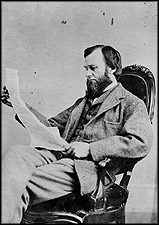 Spencer F. Baird, ca. 1860, SIA. |
It is fortunate for the Smithsonian that both Henry and his second-in-command, Assistant Secretary Spencer F. Baird, were born and bred in the North. Henry was circumspect in expressing political opinions in public and even in private and was very careful to keep the institution apolitical, as he had even before the war. On April 26, he wrote his brother-in-law, "I perhaps ought not to say anything in the present condition of affairs, considering the position I hold in regard to the country." It is clear from his private correspondence, however, that he abhorred war and that he favored a peaceful separation, rather than a bloodbath. He feared that in the end the country would be "as far from a harmonious union as we now are." Henry was personally opposed to slavery but, like many others of the time, favored colonization in Africa over abolition. He felt that liberated blacks would always be at a disadvantage in "the battle of life," especially in the temperate zones. Two years after the war, Henry wrote former president Millard Fillmore that it would have been better for the government to have purchased all the slaves and set them free than to have fought the war.6
Although Baird's father-in-law had been inspector general of the United States Army, Baird was no more eager for war than Henry. He opposed forcing the South to remain in the Union and privately joked about being a secessionist. At thirty-eight years of age, he not only did not volunteer but cautioned other young men not to volunteer. He also clearly saw the Smithsonian as a supra-national organization, an institution founded, in the words of James Smithson's will, "for the increase & diffusion of knowledge among men," meaning throughout the world. He thus expressed a sentiment undoubtedly shared by Henry: "Whatever power may control Washington, it is our hope to be allowed to carry out our sublime mission in the most catholic manner."7
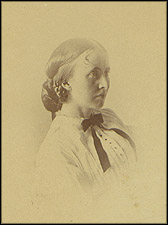 Mary Henry, n.d., SIA. |
Once Union troops were in place to defend Washington, Henry recognized a new problem: "Our greatest danger now is the collection, in this city, of so large a number of men unused to the privations of military life and the restraints of a well regulated army." In her diary, his oldest daughter wrote of streets filled with soldiers and the sound of drums. Mary Henry found the flashy New York Zouaves "quite disorderly since their arrival." One day she looked out of the Henry family living quarters on the second floor of the Smithsonian Building and found a German regiment drilling under the windows. As Union troops moved across the river to take up positions in Virginia, she got a pass to visit the encampments and found them "indescribably picturesque." Speaking of the war, Henry wrote his brother-in-law that his daughters "have experienced only a few of its inconveniences but have not been called upon to witness any of its horrors."8
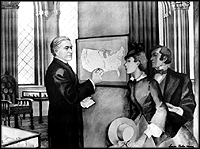 Henry demonstrating weather map, by Louise Rochon Hoover, 1933, SIA. |
The Smithsonian soon began to feel the impact of the war on its programs. One of the first to be affected was its national network of volunteer weather observers. As soon as the war started, observers in the South and many in the West stopped sending monthly reports to Washington. After the war, an observer in Richmond wrote Henry that he had sent his returns to Washington until the mails were interrupted and had then held them pending a resumption. He sadly informed Henry that when troops under General Sheridan had occupied his house, his barometer had been broken and the mercury taken out. Even in the North, reporting was disrupted as some observers left for military duty on short notice without getting substitutes. The program was also hurt by government preemption of the telegraph lines, which were previously used by telegraph operators to report daily weather information for display on a map in the Smithsonian Building and for publication in the evening paper. Henry wrote in December, "Our system of meteorology has been sadly broken in upon by the war."9
The war affected the Smithsonian's pocketbook also. The institution had three main sources of income at this time. The first derived from the principal of Smithson's bequest, which was deposited in the United States Treasury and yielded about $31,000 a year. Henry began worrying as early as January 1861 that the United States government might not honor its obligation to pay interest on the bequest. The government did pay the interest during the war, although the payment was sometimes late and payments after January 1862 were made not in gold but in devaluated currency, which drastically reduced the Smithsonian's purchasing power. According to Baird, Henry's response to the prospect of diminished funding was that "all superfluous expenditures were to be lopped off, and the most rigid economy exercised."10
The second source of income derived from the interest the bequest had earned in the eight years after the money arrived in the United States in 1838 and before Congress established the Smithsonian in 1846. Some of the $242,000 in interest thus earned had been spent on the construction of the Smithsonian Building, but there was still $141,000 of this accrued interest available. The Smithsonian had invested the money in state bonds, specifically in the bonds of Indiana, Virginia, Tennessee, Georgia, and the District of Columbia. When Virginia, Tennessee, and Georgia joined the Confederacy, the Smithsonian lost the interest on these bonds, a loss of about $4,000 a year.11
The third source of funds was a $4,000 annual appropriation by Congress for the care of the national collections. These funds were the first to be affected, even before the war started. In December 1860, Henry wrote a friend that the government had stopped payment and the Smithsonian was unable to draw the semi-annual sum of $2,000. Three weeks later, Henry wrote that if Congress failed to appropriate money for the museum, "we shall be obliged to close the doors or charge an admittance to visitors."12
Another program to be affected almost immediately was the Smithsonian's international exchange system. Since 1851, the institution had offered to act as an exchange agent for individuals and learned societies in the United States and for their counterparts abroad. Publications from throughout the United States were sent to the Smithsonian to be shipped and distributed abroad, while foreign publications were received by Smithsonian agents abroad and shipped to the Smithsonian for distribution to recipients in the United States. On May 1, 1861, Henry notified the American participants that "in consequence of the unsettled condition of the country, and the present interruption of transit to and from Washington, the Smithsonian Institution undertakes no responsibility as to what may be sent to it for transmission abroad." He also warned that, due to increased freight rates, the institution might request reimbursement for actual costs. Facilitating the dissemination of scientific publications throughout the world was a priority for Henry, however. Baird assured the Smithsonian's agent in Germany that "in a crippled condition of the Smithsonian resources, the foreign exchanges will be the last to suspend operations." Although the number of pounds shipped decreased in 1861, from 20,000 the year before to 17,000, the following year the Smithsonian shipped almost 29,000 pounds of material. This program was able to continue partly because steamship lines, railroads, and freight companies transported packages for free or at reduced rates.13
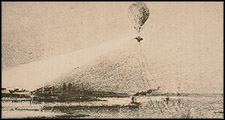 A night balloon observation, ca. 1861-62. |
Despite Henry's lack of enthusiasm for the war, he soon began contributing to the Union effort. When balloonist T.S.C. Lowe approached Henry for financial aid in the spring of 1861, Henry realized that Lowe's balloon could be "of advantage to the Government in assisting their reconnaisance of the district of country around Washington." Henry summoned Lowe to Washington, where he introduced him to Secretary of War Simon Cameron and then to Lincoln himself.14
In mid-June, Lowe ascended from the site now occupied by the National Air and Space Museum to prove the feasibility of communicating by telegraph between balloons and the ground. After examining Lowe's balloon and witnessing his demonstration ascents, Henry endorsed balloons as an effective way to assess topography and enemy positions. With Henry's support, Lowe became head of a balloon corps that was to provide Union commanders with accurate information. According to historian Robert V. Bruce, this was the first successful military air force in American history. Despite the military potential of balloons, however, Lowe proved to be a poor administrator. This weakness, coupled with rivalries with other aeronauts and the inability of the military to properly use the information reported, undermined the potential contribution of balloons to the war effort.15
 View from north tower, ca. 1867, SIA. |
The Smithsonian began experimenting in another area of military intelligence at this time. The height of the Smithsonian Building's highest tower made it a superior location to test signalling systems. We have found several references to the testing of different signalling systems between the Smithsonian and the Coast Survey office on Capitol Hill, between the Smithsonian and Fort Washington sixteen miles south of the city, and between the Smithsonian and the U.S. Soldier's Home, which was on the second highest elevation in Washington. One night in August of 1864, for example, Henry and others signalled across the Smithsonian grounds with two lime-light lanterns. The next night they put one lantern in the tower of the Smithsonian Building and the other in the tower of the Soldiers' Home near Lincoln's summer White House. Lincoln was present at this August demonstration.16
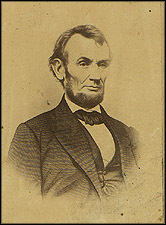 Abraham Lincoln, by Anthony Berger, 1864, SIA. |
Perhaps the best known anecdote relating to the Smithsonian during the Civil War relates how someone saw lights flashing from the Smithsonian tower at night and went to Lincoln to report Henry as a traitor for signalling the enemy. This story has been told with many variations, including the following from Carl Sandburg's biography of Lincoln: "One dark night Lincoln with four other men climbed up the tower of the Smithsonian Institution. Toward hills encircling Washington they flashed signals. The next day an army officer marched into Lincoln's office a prisoner, Professor Joseph Henry, secretary and director of the Smithsonian Institution, the most eminent man of learning in the employ of the United States Government. 'Mr. President,' said the officer, 'I told you a month ago Professor Henry is a rebel. Last night at midnight he flashed red lights from the top of his building, signaling to the Secesh. I saw them myself.'
Lincoln turned. 'Now you're caught! What have you to say, Professor Henry, why sentence of death should not immediately be pronounced upon you?' Then, turning to the army officer, Lincoln explained that on the previous evening he and others had accompanied Henry to the Smithsonian tower and experimented with new army signals." Although we have not been able to document Sandburg's account, Henry was in fact accused of treason by C. F. Anderson, an Englishman, who also accused Quartermaster General Montgomery C. Meigs of signalling the enemy from the Capitol Building. According to an 1861 letter written by Meigs, who learned of the incident from Henry, Henry happened to be visiting the president one evening in 1861 when Anderson accused both him and Meigs of treason. Henry spoke up and defended himself and Meigs.17
Fears for the safety of the capital flared again with the unexpected rout of an inexperienced and untrained Union army at Bull Run on July 21, 1861. The defeat also dashed hopes for an early end to the war. Henry wrote to a former student, "That the north will be able, in time, to conquer the south can scarcely be doubted but when this will be accomplished is much more indefinite than it was supposed to be ten days ago." As troops straggled back into Washington, Mary Henry was not alone in her opinion that the Confederates could have pushed on and captured the capital. She noted ambulances passing the Smithsonian Building all night and streets crowded with soldiers.18
Following the battle, George McClellan was put in charge of the army and began systematically training his troops and imposing discipline. John Varden, caretaker of the Smithsonian museum, wrote Baird that "such strict disiplin is observed by General McLelland thare are but fiew Soldiers now visiting the Museum." Henry wrote his friend Asa Gray of Harvard that "a great change has taken place since Gen. McClelland took command and our streets are now as orderly as those of Cambridge." He felt confident enough to leave town in August for two to three weeks "provided I am not recalled by the intelligence of the danger of an attack on the city." He returned to a Washington expecting enemy advances and at the beginning of what was to be a five-month Confederate blockade of the Potomac. Faced with Confederate guns on the riverbanks south of Washington, the U.S. Navy officially closed the river. With a swollen wartime population and supplies limited to what could be brought in on the Baltimore and Ohio Railroad, prices soared and supplies became scarce. Henry wrote his wife that the boat carrying the Smithsonian's coal for the winter could not proceed until the navy promised to escort it up the river in the dark and that a rumor was circulating that President Lincoln had been captured while on a trip down the river.19
While rumors of impending Confederate attack periodically swept the capital, throughout the war there was also continuing suspicion of southern sympathizers and spies in Washington. Between August 1861 and the end of the year, one hundred government employees refused to take a loyalty oath. Washington Mayor James G. Berret, a regent of the Smithsonian by virtue of his office, refused to take the loyalty oath, was imprisoned for a month in New York, and resigned as mayor.20
 Smithsonian lecture hall, ca. 1856-57, SIA. |
Late in 1861, one hundred prominent Washington citizens formed a group called the Washington Lecture Association and petitioned Henry for use of the Smithsonian's lecture room. This was the best lecture hall in Washington with excellent acoustics and sight lines and a seating capacity of two thousand. The Smithsonian used it for its own lectures, which were usually on scientific or historical topics, but also gave permission to outside groups under three conditions: if they paid for watchmen and utilities, if their object was "consistent with the character of the Institution," and, most important, if they agreed to exclude "any subject connected with sectarianism, discussions in Congress [italics in original] and the political questions of the day."21
Although the Washington Lecture Association agreed to these restrictions, the series soon revealed itself to be a forum on the abolition of slavery, perhaps the most explosive issue of the day. The lecturers included such leading abolitionists as Horace Greeley, Henry Ward Beecher, and Wendell Phillips. Feeling betrayed by the committee's misrepresentation of their purpose to him and by their blatant violation of Smithsonian policy, Henry insisted that a statement be read before each lecture disclaiming Smithsonian responsibility. In his biography of Abraham Lincoln, Carl Sandburg wrote that the chairman of the lecture series would open each lecture by saying: "Ladies and gentlemen: I am requested by Professor Henry to announce that the Smithsonian Institution is not in any way responsible for this course of lectures. I do so with pleasure, and desire to add that the Washington Lecture Association is in no way responsible for the Smithsonian Institution." The hall would rock with laughter at Henry's expense. After the lecture series ended, Henry and the Smithsonian's executive committee decided to refuse all applications for use of the lecture hall except those from public school principals, who used the hall for student award ceremonies.22
At the same time he was being both criticized for allowing abolitionist lectures at the Smithsonian and ridiculed for disclaiming responsibility for them, Henry became the target of rumors questioning his loyalty to the Union. A mutual friend wrote Alexander Dallas Bache, a Smithsonian regent and one of Henry's closest friends and advisors, that he had heard from "two entirely different & independent sources that his [Henry's] sentiments are no secret & even acts indicating disloyalty are cited." Henry's prior friendship with Jefferson Davis was particularly suspect. Before becoming president of the Confederate States of America, however, Davis had distinguished himself in service to the United States, as a graduate of the United States Military Academy, as an officer in the Mexican War, as a representative and senator from Mississippi, and as secretary of war in Franklin Pierce's administration. As a regent of the Smithsonian from 1847 to 1851, he was one of Henry's most consistent supporters on the Board of Regents and an effective advocate in Congress of the Smithsonian's interests.23
The departure of other Smithsonian regents for the South presumably caused the Smithsonian some embarrassment. Lucius J. Gartrell of Georgia retired from the House of Representatives in January of 1861 and declared his allegiance to the Confederacy. He was followed in March by Senator James M. Mason of Virginia. Kentuckian John C. Breckinridge, who had run against Lincoln in the election of 1860, was expelled from the Senate in December of 1861. All of these men assumed important positions in the Confederacy. Later George E. Badger, a citizen regent from North Carolina, was expelled at a regents' meeting in February 1863 for "giving aid and comfort to the enemies of the Government." In January 1864, another regent, Senator Garrett Davis of Kentucky, was accused of treason in the Senate but was not expelled from that chamber and remained on the Board of Regents until his death eight years later.24
In early 1862, conditions were grim in Washington. The city was crowded with soldiers, strangers, and, as always, office seekers. Streets were dirty and torn up by army wagons. Henry wrote a friend that the mud was so bad around the Smithsonian that he and his staff couldn't communicate with the rest of the city except by hiring expensive carriages. The route from the Smithsonian to central downtown led through an area crowded with criminals and prostitutes. Juvenile delinquents followed the army, and disease, throughout the war a greater threat to Washington than the Confederate army, was rampant.25
In March, General McClellan moved troops by water to Fortress Monroe, some seventy miles southeast of Richmond. Mary Henry crossed the river to Alexandria to see them off after first visiting the provost marshal to take a loyalty oath. In June, hearing of a battle near Richmond in which his friend General Silas Casey was wounded, Henry mused on the public's taste for war: "How strange is the state of feeling which now pervades the public mind. Tender females, who would shrink from the sight of the death of a chicken, and who will shed tears over the ills of an imaginary hero of romance, can now rejoice at the slaughter of thousands of gallant men, and the suffering and death of hundreds of helpless women and children."26
In the spring and summer of 1862, fear of invasion once again swept Washington. By late June, wounded soldiers were pouring into the city from McClellan's peninsular campaign. Many of the wounded arrived by boat at the Sixth Street wharves a few blocks south of the Smithsonian. Mary Henry made bandages and visited hospitals, many of which presumably used a disinfectant that the Smithsonian manufactured by the gallon in its chemical laboratory. A large hospital complex built around the Armory at 6th St. and Independence Avenue was just a few blocks east of the Smithsonian Building.27
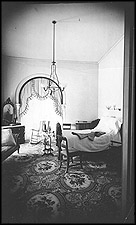 Bedroom in the Henry apartments, by Thomas W. Smillie, ca. 1878, SIA. |
After a second Union defeat at Bull Run in late August 1862, troops retreated to forts around Washington. Despite very hot weather that made the Smithsonian Building feel like an oven, Henry stayed in town to oversee the printing of the Smithsonian's annual report for 1861. He noted the temperature in his bedroom as 91 degrees at midnight.28
Henry's daughters Helen and Caroline and son Will had left for Long Island in May. To escape the heat, Henry, his wife Harriet, and daughter Mary left Washington on August 28 to visit a friend in Sykesville, Maryland, but Henry was so worried about a possible invasion of the city that he hurried back to the Smithsonian on September 3. He found troops solidly entrenched around Washington and the hospitals "filled to overflowing." In the fall of 1862, there were 56,000 wounded soldiers and sixty hospitals in Washington, many housed in churches and other large buildings. Assured of the city's safety from invasion, Henry rejoined his family in Sykesville, but, in his words, "soon after we were comfortably settled and were enjoying the cool quiet and pure air of the region we found ourselves with-in the lines of the scouts of the enemy and were obliged to fly."29
The Confederate army had crossed the Potomac thirty-five miles above Washington on September 4 with the hope of cutting the capital's links to the west and rallying Maryland to the Confederate cause. This advance culminated in the battle of Antietam on September 17, the bloodiest day in American history with casualties several times greater than those suffered by Americans on D-Day in World War II. Union forces won the battle although Confederate troops were able to retreat without being destroyed.30
John Varden, who had remained at the Smithsonian, wrote the vacationing Baird of the fear permeating Washington. He confessed, "I doe ashure you that if I had it in my Power I should think it no disgrace to (Skedadel)." He concluded "I am not nor can I doe much in the way of work at this time on acct of the excitement." Solomon G. Brown, an African-American assistant to Baird, wrote "We can do but little work here we have no [?heart]--for Every Place and Streets is filled with the Poor cut up men."31
Having fled Confederate pickets in Maryland, the Henrys were still in New York in October, with the exception of William who had returned early to his job at the Smithsonian. Upon receiving a telegram that Will was seriously ill, Henry and his wife rushed back to Washington, where their oldest child and only son died on October 17, 1862, of a "billious attack," or jaundice, in the family quarters in the east wing of the Smithsonian Building. The Henrys buried Will in Princeton and remained there to wait for heavy frosts in Washington. As Henry's close friend John Torrey wrote, "They are afraid of malaria at the Smithsonian." Henry wrote that his son's death "has lessened my desire to live and were it not that I am anxious as to the future condition of my family I would scarcely wish to continue longer to fight the battle of life particularly in the present unhappy condition of our country and the darkness which rests on the future. I am however earnestly and industriously pressing on the operations of the Institution."32
One of the Smithsonian's major operations was its publication program, which was adversely affected during the war by the high cost of paper as well as by higher costs for printing. The Smithsonian's annual report to Congress was printed at government expense and was only delayed during the war. The Smithsonian Contributions to Knowledge, however, was printed at Smithsonian expense and was costly. This refereed series of scholarly memoirs was the cornerstone of Henry's interpretation of Smithson's mandate to increase and diffuse knowledge throughout the world. While Henry sustained the series during the war, volumes appeared much less frequently. Whereas the Smithsonian had published a volume each year since 1851, during the war it published one in 1863 and one in 1865. Henry found it hard to devote as much attention to oversight of the series and had to apologize in several instances for not checking articles carefully enough prior to publication. He was also more selective in what he accepted, turning down particularly expensive memoirs on the basis of cost.33
In February 1863, Henry was named to a three-member board charged with advising the government on scientific matters. The newly-constituted Permanent Commission of the Navy Department evaluated warship designs, signalling systems, inventions of torpedoes, underwater guns and other ordnance, and made several hundred formal reports on proposals submitted to it. In its most active period, the commission met three times a week, often at the Smithsonian Building. Historian Nathan Reingold has concluded that the commission's function was largely negative. It sorted through the flood of proposals received by the Navy and rejected all that were not extremely promising. After the war Henry wrote ex-president Millard Fillmore that the Permanent Commission saved the "government from rushing into many schemes which, under the guise of patriotism, were intended to advance individual interests." Henry later attributed various attacks on him to inventors whose proposals he had rejected as a member of the Permanent Commission.34
Although Henry lamented the human losses caused by the war, he recognized that it offered opportunities for basic scientific research. "The art of destroying life, as well as that of preserving it, calls for the application of scientific principles, and the institution of scientific experiments on a scale of magnitude which would never be attempted in time of peace." He foresaw "investigations as to the strength of materials, the laws of projectiles, the resistance of fluids, the applications of electricity, light, heat, and chemical action, as well as of aerostation [ballooning]." Historian Robert V. Bruce has pointed out, however, that most of the technology that was actually used in the Civil War was invented before the war and that because the war was not expected to last long, little research was initiated. The military, particularly the army, was also resistant to technological innovation. Bruce has concluded that "science and scientific technology had little effect on the war." He also concluded that the war actually had a negative effect on science, by diverting personnel and resources, and on individual scientists, who were distracted at the least and sometimes killed. He mentions particularly the case of George Gordon Meade, best known as the commander of Union forces at Gettysburg, but who before the war had been a captain in the army's Corps of Topographical Engineers in charge of the Great Lakes Survey. Henry had cautioned Meade not to become "mere food for powder." Meade survived the war but never returned to science.35
June of 1863 once again brought rumors of an impending Confederate attack on Washington. On June 29, Mary Henry noted in her diary that there were ten thousand rebels in Rockville, Maryland. Confederate forces engaged the Union army not on the outskirts of Washington, however, but at Gettysburg, where a northern victory coupled with the Confederate surrender of Vicksburg marked the turning point of the war.36
Before leaving for the North in late August, Henry decided to oust most of the naturalists who were living in the towers of the Smithsonian Building. For some years these men had used the Smithsonian Building as lodgings, between exploring trips to the West. Henry wrote the vacationing Baird that "I have made quite a stir in the Institution by requesting all who have slept in the building except Mr. Meek and De Beust to find lodgings elsewhere." He continued, "If we live to reassemble after this vacation the legitimate business of the Institution must be pressed on more vigerously than it has been done during the past twelve months." After detailing what needed to be done, he ended on a note that must have sounded ominous to Baird. "All this must be done with diminished funds and therefore I think that for the present we must stop, as far as possible all expenditures on new investigations in Natural History."37
Despite Henry's threat, scientific specimens continued to pour in throughout the war. Although in 1862 Baird remarked on "an appreciable falling off in the number of snakes bugs and the like, received," Smithsonian collections grew dramatically in these years. With roughly 55,000 entries in the record books for 1860, the number doubled to roughly 112,000 entries by the end of 1865. Early in the war, the Smithsonian received the collections of the defunct National Institute for the Promotion of Science, which had been housed in the Patent Office Building. Although fewer exploring expeditions took to the field, there was activity in some relatively unexamined areas such as the Arctic and the Pacific Coast. In 1863, for example, Robert Kennicott shipped three thousand pounds of specimens from the Northwest. In his report for 1863, Henry also mentioned a series of birds and eggs from Labrador, fishes, birds, reptiles, and shells gathered by John Xantus in Mexico, and collections from Costa Rica, Guatemala, Panama, Cuba, Trinidad, Jamaica, and Ecuador. Throughout the war specimens kept arriving and the Great Hall of the Smithsonian Building was often crowded with visitors. Noting the wartime population of strangers in Washington, Henry wrote, "the museum has consequently been continually thronged with visitors, and has been a never-failing source of pleasure and instruction to the soldiers of the army of the United States quartered in this city or its vicinity."38
Henry had long argued that a national museum should be fully supported by the federal government, and that it should not and could not be fully sustained by Smithsonian funding. The annual congressional appropriation covered only part of the cost of supporting the museum and was subject to the whims of Congress. In January of 1862 a move had been made to strike the $4,000 appropriation on the grounds that money to care for the collections could come out of the Smithsonian's funds. When Louis Agassiz, a Swiss-born zoologist and director of Harvard's Museum of Comparative Zoology, became a Smithsonian regent in February 1863, he drafted a report recommending that the museum be separated from the Smithsonian and supported entirely by Congressional appropriations. Agassiz's report was burned in an 1865 fire in the Smithsonian Building, however, and a Congress struggling to pay for the war was not eager to incur additional obligations.39
 Solomon G. Brown, n.d., SIA. |
As prices rose in early 1864 and the pressure on the U.S. Treasury increased, Henry continued to keep "a sharp eye" on Smithsonian expenditures and correctly predicted an operating deficit for the year, the first ever incurred. In July, Solomon Brown noted a sudden rise in prices "so that the cost of living since Saturday last is awfull in the extreme." Three weeks later he wrote Baird again that "Prof Henry dont seem willing to allow his men more wages and I for one can not at the Present rates of Living remain for the same money, therefore I fear that I can not remain until you return." Henry himself informed Bache in September of 1864 that his income was some $400 short of his expenses during the previous year and that he had just received a notice from the Internal Revenue Office that he had to pay an additional five percent tax on his income for 1863, which he referred to as "ex post facto exaction." Newspapers reported that government clerks were resigning, unable to live on their salaries with prices and taxes so high.40
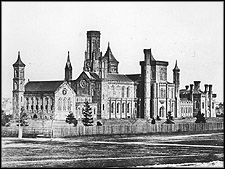 Smithsonian Building from the southwest, ca. 1858-64, SIA. |
On July 15, 1864, Solomon Brown wrote Baird that many in Washington "have been much frightened at the annual visit of the Rebels to their friends at Maryland" and that "the Building is very slimly attended by visiters scarcely one person to be seen in museum at any one hour in the day." Brown prepared a place in the coal cellar under the south tower of the Smithsonian Building to store valuables in case they couldn't be shipped out of town for safekeeping before a Confederate attack. For about a week in July, invasion was threatened as fifteen thousand soldiers under Jubal Early crossed the Potomac north of Washington and advanced to within five miles of downtown. Ulysses S. Grant, now commander in chief of the Union army, had moved many of the troops defending Washington to Virginia. Confederate troops cut communications with Baltimore, pillaged in Silver Spring, and fired on Fort Stevens off of Georgia Avenue near the District-Maryland line. Grant ordered the Sixth Corps back to the city, where it arrived just in time. Although the Confederates soon retreated, their ability to get so close to the seat of the federal government resulted, according to Henry, in "much indignation expressed as to the condition of our defenses and the unprepared state in which we were found." The scare sent the price of gold skyrocketing and led to a call for five hundred thousand new recruits, with a draft if necessary.41
Although several Smithsonian employees were young enough to be drafted, none actually served. At forty-one years of age in 1864, Spencer F. Baird was still eligible but took advantage of a special provision and hired a "colored substitute" for three years at a cost of $278. Solomon Brown wrote Baird in September that he had received a draft notice but was "Exempted on the grounds of Physical disability." Chief Clerk William Jones Rhees and paleontologist Fielding B. Meek were also drafted but were excused by the examining surgeon.42
Two months after the fall of Atlanta on September 2, 1864, Abraham Lincoln was reelected. With strong leadership assured, with a string of military victories, and with the Union army increasing in size and strength, the end of the war seemed near. As the year ended Henry reflected on the "truly astonishing . . . number of persons connected with this Institution who have passed away since the commencement of the war," and named among the regents Senator Stephen A. Douglas of Illinois, Senator James A. Pearce of Maryland, Chief Justice Roger Brooke Taney, General Joseph Gilbert Totten, Cornelius C. Felton, former president of Harvard, and William L. Dayton, U.S. minister to France. Among the employees, he listed his son William, William McPeak, a messenger, doorkeeper, and janitor at the Smithsonian since its earliest days, and John Connor, a laborer at the institution for fifteen years. Henry shared his reflections with Alexander Dallas Bache, a close friend and colleague for over thirty years. Bache had been on the Board of Regents since its first meeting in September 1846, had engineered Henry's election as secretary, and had then schooled him in the ways of Washington. As superintendent of the United States Coast Survey, member of both the Permanent Commission of the Navy Department and the United States Light-House Board, and president of the National Academy of Sciences (founded in 1863), Bache had his hands more than full during the war. Overworked and unable to escape Washington to conduct field work, Bache had suffered a breakdown from which he never fully recovered. Henry wrote to him in Europe, where he had gone to recuperate. "You are now the only Regent originally appointed and when I next address the Board not a single member will be present who has been connected with the establishment more than a very few years. You may be sure that I feel some solicitude as to the future now standing as it were alone."43
With the large turnover on the board of Regents, Henry became very concerned about the choice of new regents. He was adamant that the citizen regents, those who were not either senators or representatives or ex-officio members, be "above all suspicion of wanting the position for personal advantage," but was even more concerned that the management of the institution "as far as possible should not fall entirely into the hands of partizan politicians." Although the power of appointing regents was not in his hands, Henry felt obliged to become involved. As he wrote Benjamin Silliman, urging him to persuade the president of Yale, Theodore Dwight Woolsey, to accept his impending election as a regent, "It is by no means pleasant or proper for me to meddle with the appointment of the Regents, but I have always considered it my duty to request the nominating power to select persons of high character and of liberal views as to the importance of abstract science."44
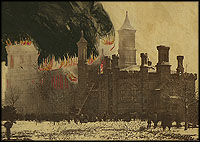 Smithsonian Building on fire, by Alexander Gardner, 1865, SIA. |
On January 24, 1865, a major fire broke out in the Smithsonian Building. Henry had been concerned about the danger for years and had taken preventive measures such as prohibiting smoking and open fires, starting a night watch, and stationing containers of water in various locations. Despite these precautions, a fire broke out between the ceiling and the roof of the main building when workmen hanging pictures in the second floor picture gallery inserted a stove pipe into a furring space rather than into a flue. The fire, which attracted thousands of spectators according to Mary Henry, destroyed the second floor and roof of the main building as well as portions of the towers. The lecture room, apparatus room, and picture gallery were destroyed, including almost all of John Mix Stanley's irreplaceable collection of paintings of Native Americans, which had been on exhibit in the building since 1852. The contents of Henry's office between the two front towers burned, including virtually all of the official correspondence of the office of the secretary since the founding of the Smithsonian in 1846. In the south tower, the contents of the regents' room, including James Smithson's personal effects, also burned. The Smithsonian library in the west wing and the museum on the ground floor of the main building were spared, thanks both to a wind from the west and the fireproof materials used in the construction of the museum area.45
Henry reacted to these losses with surprising equanimity. As Mary Henry observed, "Father bears the misfortune with the utmost patience and sweetness." The reasons for his attitude are not hard to find. The fire aroused expressions of sympathy for the Smithsonian. As the Cambridge astronomer Benjamin Apthorp Gould assured Henry, "The Institution has no opponents now;--friends everywhere; who will stand by it & do all that you may desire in its behalf." Henry quickly realized he could use the fire to further advance his vision of the Smithsonian. He expected the "large amount of kind feeling in regard to the Institution, to direct the attention of Congress to the character and importance of its operations," thus providing "the opportunity of remedying some of the defects in the original law of its organization," that is, saddling the Smithsonian with a large building, museum, library, art gallery, and lectures. Henry had always been opposed to the large Smithsonian Building, believing that the institution was intellectual in nature and worldwide in its reach and was only hampered by a museum few could visit and by a large and expensive building.46
The military put a temporary roof on the building by January 28. Henry decided not to reconstruct the lecture room, happy to be free of the problems associated with it. He used the fire to strengthen his longstanding contention that the Smithsonian library should be deposited in the Library of Congress, which was just finishing new fireproof quarters; the transfer took place in 1866.47
Henry also used the fire to strengthen his request that the semi-annual interest on the Smithson bequest be paid in gold rather than in devalued currency. Henry had first made this request of Secretary of the Treasury Salmon P. Chase in July of 1864, but had been advised that the tremendous pressures on federal finances would not permit it. When the regents debated whether to seek a congressional appropriation to repair the building quickly and without using up any of the extra fund, Henry reiterated his longstanding distrust of any federal funding for the Smithsonian. He decided to press for getting the interest paid in gold, which would produce additional funds for the repair of the building without incurring any obligations to Congress. Although one congressman questioned why the Smithsonian should be paid in gold when soldiers were paid in currency, Henry was ultimately successful not only in getting the interest paid in gold but in getting retroactive payments in gold back to January of 1862. Although the reconstruction of the building cost around $150,000, and thus raised the total amount spent on the building to around $475,000, by 1867 the Smithsonian had gotten authority from Congress to add to the Smithson bequest in the United States Treasury both a residual bequest and the amount remaining of interest earned on the Smithson bequest prior to 1846. Within less than two years of the end of the war, the Smithsonian's endowment had risen from $515,000 to $650,000.48
On April 4, 1865, following the fall of Richmond, Washingtonians celebrated the approaching end of the war by illuminating buildings and draping them with flags. Two days later, Mary Howard Schoolcraft, widow of the ethnologist Henry Rowe Schoolcraft and a southerner by birth, wrote Henry to alert him about a letter published in the Washington Chronicle of that morning: The letter read: "It has been currently reported that since the breaking out of the rebellion four years ago, the United States flag has not been seen to wave over the Smithsonian Institute. If this is so, can any one give the reason why?" Mrs. Schoolcraft warned Henry, "We are living in times, where the public mind is kept in a boiling caldron, of passionate, & unreasoning excitement, so that it is the part of wisdom to furnish no extra fuel to the flame, and therefore if in the multiplicity of your cares, & sorrows, you have overlooked this flag temporarily I beg to call your attention to it, as one of the strange but imperious requirements of the present day. I have the whole family of flags in our house, and intend to fling them out of every window, and illuminate from Cellar to Attic, the moment an honorable Peace, to both parties, is announced." Henry thanked her the next day, attributing the newspaper attack to one of the many inventors whose proposals he had rejected, concluding, "I must expect the discharge against me, of an occasional poisoned arrow."49
On April 9, Henry penned a private explanation in his diary: "No flag has been hoisted on the Institution because at the beginning of the war the government was unable to put the city in a state of defense and the public buildings belonging to the government were liabl on a capture of the city to be destroyed. It was therefore concluded that the Institution as a purely scientific establishment the endowment of which was the gift of an Englishman to men of all nations it was best to stand on this grown and should the building be assailed to appeal to the sense of propriety of the [?traytors]." On April 11, Henry called at the War Department to try to borrow a flag to be displayed during a grand illumination ordered by city authorities for April 13. He couldn't find one either there or at the Navy Department.50
The following week, Henry delayed a trip to New York to oversee the illumination of the east end of the Smithsonian Building. Shortly after arriving at the Astor House in New York on April 14, he overheard a man who had just returned from the telegraph office with the news that President Lincoln had been shot. Arriving back in Washington in time for the funeral, Henry found a letter from General Richard Delafield, a regent who had just returned from seeing the United States flag restored over Fort Sumter. Delafield wrote: "I looked in vain for the National Banner at And over the Institute. Before leaving here I had hoped to have impressed you with the propriety of its being always used by the Institute on occasions when the public authorities cause it to be hoisted elsewhere." Henry noted in his diary that he was offended by the tone of Delafield's letter. He also noted that his wife had gotten a flag from Rear Admiral Charles Henry Davis that they would fly over their residential quarters in the east wing the next day.51
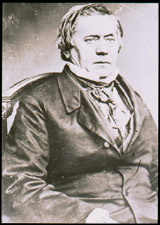 Joseph Henry, by Mathew Brady, ca. 1862, Brady Collection. |
There is no evidence, incidentally, of any disloyal acts by Henry despite his regrets about the war, his respect for Jefferson Davis, and his failure to, literally, wave the flag enough. With little fanfare, Henry devoted hundreds of unpaid hours to the Union effort. In historian A. Hunter Dupree's evaluation, Henry's services were the Smithsonian's one effective contribution to the Union effort. Henry somewhat bitterly remarked to Baird near the end of the war, "I know that I shall not be considered as good a patriot as some of your friends I could name; who while expressing with one hand in violent gesticulations their devotion to their country have with the other been filling their pockets with the spoils of office."52
As representatives of the Smithsonian, Henry and Baird attended Lincoln's funeral services in the East Room of the White House. Henry lamented Lincoln's death and believed Lincoln was trying to end the war "as humanely as possible." In regard to his successor, he prayed "that the mantle of Lincoln may fall upon him that he may be imbued with the same honesty of purpose, the same kindness of heart and the same moderation and prudence of action."53
And so the bloodiest four years in the history of the republic finally ended. The Smithsonian had endured the prospect of Confederate attack or occupation by Union troops, as well as ridicule, guilt by association, allegations of disloyalty, the deaths of several staff members and regents, and a major fire that destroyed virtually all of the official records of the institution since its founding. Despite everything, the Smithsonian emerged from the turmoil of war in a surprisingly strong position. To explain this, we need to look to Joseph Henry.
Henry never lost sight of what he wanted the Smithsonian to be. When public buildings in Washington were threatened, he asserted the institution's private status. When the federal government hesitated in paying interest on the Smithson bequest, Henry reminded it of its solemn obligation. When a fire damaged the Smithsonian Building, Henry used it to eliminate functions he saw as secondary to the core mission of the Smithsonian. With his vision of an institution devoted to the support of basic research and dissemination of its findings throughout the world, he took the interruptions and embarrassments caused by the war and used them to further realize that vision.